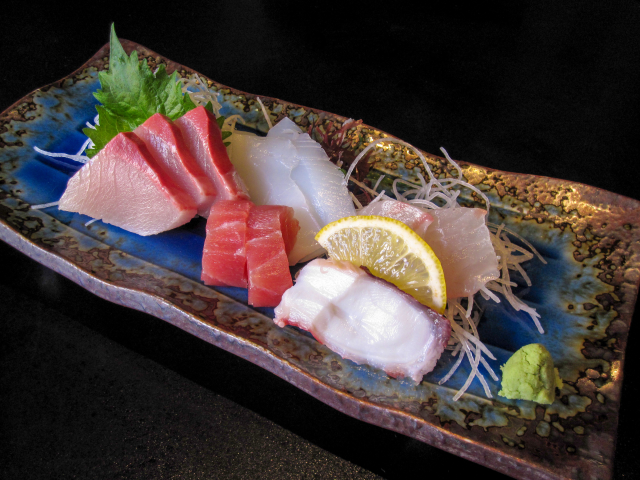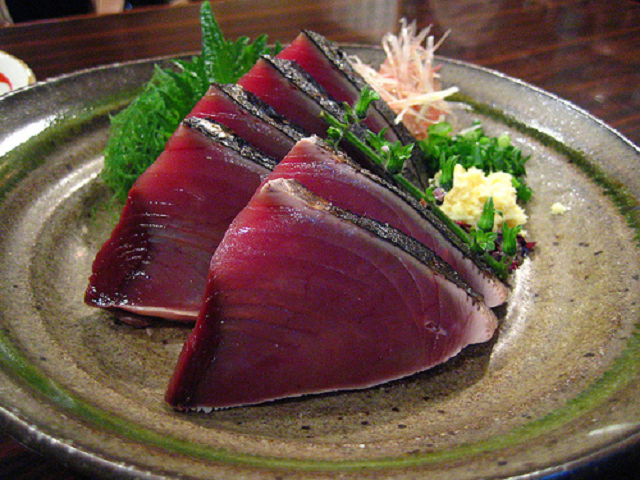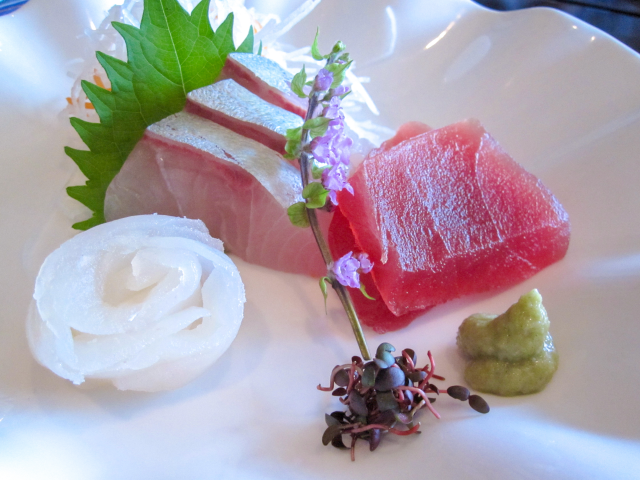
It’s not the fish that’s changing, but who gets to eat it.
The coronavirus pandemic is convincing a lot of people to eat at home, and for many that means plenty of delivery pizza and instant ramen. While those are both fortifying comfort foods, they’re not what most people would call fine dining, and so understandably a lot of foodies are eager to return to their favorite restaurants as soon as they can.
However, there might be an unexpected culinary upside to the pandemic: a surge in the quality and flavor of sashimi you can eat at home.
The piscatorial prophet to first put forth this theory is Japanese blogger Makoto Suzuki. Suzuki is no ordinary fish fan, as his previous job was as an auctioneer at Tokyo’s Tsukiji Fish Market, the biggest fish market in the entre world. These days, he continues to put his trained eye to use by selecting the tastiest cuts of sashimi he can find at the supermarket when doing his family’s grocery shopping, and on a recent excursion he spotted an extremely delicious-looking block of katsuo (bonito).
▼ A plate of katsuo tataki (seared bonito sashimi)
Sure enough, when Suzuki took the fish home, sliced it, and fed it to his family, they found the flavor to be off-the-charts fantastic. Granted, many sashimi aficionados will tell you that katuso caught in the spring, called “hatsu katsuo,” is better than that in other seasons, but even by that standard, Suzuki felt it was incredibly delicious, and the clue as to why, he says, is in the shape of the cross sections he sliced.
Ordinarily, Suzuki says the katsuo he can find at the supermarket has a slightly triangular cross section, as the block tapers on one side, a sign that the cut is from the outer edge of the fish. For this super-tasty sashimi, though, the cross sections were stout rectangles, meaning they came from the fish’s deeper layers, where there’s generally less meat available. However, the rectangular sashimi block weighed the same approximately 250 grams (8.8 ounces) as the tapered blocks Suzuki is used to getting at the supermarket, which in turn suggests that this extra-tasty sashimi came from a bigger fish.
According to Suzuki, the sashimi from larger bonito, especially those weighing five kilograms (11 pounds) or more, is the best-tasting. Because of that, though, big bonito usually get snatched up by restaurant buyers, who then slice them up and sell them, with a markup, of course, to eat-in customers. Meanwhile, the smaller bonito get bought by supermarkets, who sell their fish at more economical prices to shoppers.
With the coronavirus discouraging many people from dining out though, there’s less demand from restaurants, and so the prices for large bonito have dropped into the range where they’re viable purchases for supermarkets. As proof, Suzuki pulled up that results of katsuo auctions at Tokyo’s Toyosu Fish Market (which opened as Tsukiji’s replacement in 2018) for April 11, 2019, and found that on that day the highest bid for katsuo was 2,160 yen (US$20.19) per kilogram. On the same date this year, the price had fallen to half that, 1,080 yen.
Ostensibly, something similar should be happening with other high-margin foodstuffs, like beef, as restaurant demand dips, giving gourmands yet another reason to eat at home, especially if their company is generous enough to pay for their at-home drinks.
Source: Note/Makoto Suzuki via Hachima Kiko
Top image: Photo Chips
Insert images: Wikipedia/Chiewatc, Photo Chips
● Want to hear about SoraNews24’s latest articles as soon as they’re published? Follow us on Facebook and Twitter!
Follow Casey on Twitter, where after more than a decade living in Japan he’s not the least bit tired of sashimi.



 How to choose a great block of sashimi-grade tuna – 66-year maguro master shares his protips
How to choose a great block of sashimi-grade tuna – 66-year maguro master shares his protips Bluefin tuna fish sells for bargain low price of roughly US$200,000 in Tokyo auction
Bluefin tuna fish sells for bargain low price of roughly US$200,000 in Tokyo auction The secret blowfish auction — trading for deadly but tasty fugu 【Video】
The secret blowfish auction — trading for deadly but tasty fugu 【Video】 Japanese people list their top ten fish, and tuna isn’t number one
Japanese people list their top ten fish, and tuna isn’t number one Japan’s biggest ham company is making “tuna” that contains neither ham nor fish
Japan’s biggest ham company is making “tuna” that contains neither ham nor fish Red light district sushi restaurant in Tokyo shows us just how wrong we were about it
Red light district sushi restaurant in Tokyo shows us just how wrong we were about it Wendy’s releases a Pretzel Roast Beef Burger aimed at foreign tourists in Japan
Wendy’s releases a Pretzel Roast Beef Burger aimed at foreign tourists in Japan Limited-edition Carbonara Udon will anger noodle purists and pasta lovers 【Taste test】
Limited-edition Carbonara Udon will anger noodle purists and pasta lovers 【Taste test】 Japan’s massive matcha parfait weighs 6 kilos, contains hidden surprises for anyone who eats it
Japan’s massive matcha parfait weighs 6 kilos, contains hidden surprises for anyone who eats it Tokyo Tsukiji fish market site to be redeveloped with 50,000-seat stadium, hotel, shopping center
Tokyo Tsukiji fish market site to be redeveloped with 50,000-seat stadium, hotel, shopping center Haku is…Chihiro’s dead brother? Studio Ghibli fans blown away by Spirited Away theory
Haku is…Chihiro’s dead brother? Studio Ghibli fans blown away by Spirited Away theory Pokémon Sleep camping suite and guestrooms coming to Tokyo Hyatt along with giant Snorlax burgers
Pokémon Sleep camping suite and guestrooms coming to Tokyo Hyatt along with giant Snorlax burgers Beautiful Ghibli sealing wax kits let you create accessories and elegant letter decorations【Pics】
Beautiful Ghibli sealing wax kits let you create accessories and elegant letter decorations【Pics】 McDonald’s new Happy Meals offer up cute and practical Sanrio lifestyle goods
McDonald’s new Happy Meals offer up cute and practical Sanrio lifestyle goods Sakura tree falls on man at Sannenzaka near Kiyomizu temple in Kyoto 【Breaking News】
Sakura tree falls on man at Sannenzaka near Kiyomizu temple in Kyoto 【Breaking News】 Japanese ramen restaurants under pressure from new yen banknotes
Japanese ramen restaurants under pressure from new yen banknotes All-you-can-drink Starbucks and amazing views part of Tokyo’s new 170 meter-high sky lounge
All-you-can-drink Starbucks and amazing views part of Tokyo’s new 170 meter-high sky lounge French Fries Bread in Tokyo’s Shibuya becomes a hit on social media
French Fries Bread in Tokyo’s Shibuya becomes a hit on social media Studio Ghibli releases new action figures featuring Nausicaä of the Valley of the Wind characters
Studio Ghibli releases new action figures featuring Nausicaä of the Valley of the Wind characters New private rooms on Tokaido Shinkansen change the way we travel from Tokyo to Kyoto
New private rooms on Tokaido Shinkansen change the way we travel from Tokyo to Kyoto Studio Ghibli glasses cases let anime characters keep an eye on your spectacles
Studio Ghibli glasses cases let anime characters keep an eye on your spectacles Studio Ghibli releases Kiki’s Delivery Service chocolate cake pouches in Japan
Studio Ghibli releases Kiki’s Delivery Service chocolate cake pouches in Japan New definition of “Japanese whiskey” goes into effect to prevent fakes from fooling overseas buyers
New definition of “Japanese whiskey” goes into effect to prevent fakes from fooling overseas buyers Our Japanese reporter visits Costco in the U.S., finds super American and very Japanese things
Our Japanese reporter visits Costco in the U.S., finds super American and very Japanese things Studio Ghibli unveils Mother’s Day gift set that captures the love in My Neighbour Totoro
Studio Ghibli unveils Mother’s Day gift set that captures the love in My Neighbour Totoro New Japanese KitKat flavour stars Sanrio characters, including Hello Kitty
New Japanese KitKat flavour stars Sanrio characters, including Hello Kitty More foreign tourists than ever before in history visited Japan last month
More foreign tourists than ever before in history visited Japan last month New Pokémon cakes let you eat your way through Pikachu and all the Eevee evolutions
New Pokémon cakes let you eat your way through Pikachu and all the Eevee evolutions Sales of Japan’s most convenient train ticket/shopping payment cards suspended indefinitely
Sales of Japan’s most convenient train ticket/shopping payment cards suspended indefinitely Sold-out Studio Ghibli desktop humidifiers are back so Totoro can help you through the dry season
Sold-out Studio Ghibli desktop humidifiers are back so Totoro can help you through the dry season Japanese government to make first change to romanization spelling rules since the 1950s
Japanese government to make first change to romanization spelling rules since the 1950s Ghibli founders Toshio Suzuki and Hayao Miyazaki contribute to Japanese whisky Totoro label design
Ghibli founders Toshio Suzuki and Hayao Miyazaki contribute to Japanese whisky Totoro label design Doraemon found buried at sea as scene from 1993 anime becomes real life【Photos】
Doraemon found buried at sea as scene from 1993 anime becomes real life【Photos】 Tokyo’s most famous Starbucks is closed
Tokyo’s most famous Starbucks is closed One Piece characters’ nationalities revealed, but fans have mixed opinions
One Piece characters’ nationalities revealed, but fans have mixed opinions We asked a Uniqlo employee what four things we should buy and their suggestions didn’t disappoint
We asked a Uniqlo employee what four things we should buy and their suggestions didn’t disappoint Princesses, fruits, and blacksmiths: Study reveals the 30 most unusual family names in Japan
Princesses, fruits, and blacksmiths: Study reveals the 30 most unusual family names in Japan Salmon sashimi noodles: Terrifying, mouthwatering, or both?【Photos】
Salmon sashimi noodles: Terrifying, mouthwatering, or both?【Photos】 Yaizu: Japan’s best sushi market destination even most foodies in Japan have never heard of
Yaizu: Japan’s best sushi market destination even most foodies in Japan have never heard of Tokyo restaurant wins prized tuna at New Year auction for 114.2 million yen and serves it up to customers
Tokyo restaurant wins prized tuna at New Year auction for 114.2 million yen and serves it up to customers Increasing number of women leave rice behind at revolving sushi train restaurants in Japan
Increasing number of women leave rice behind at revolving sushi train restaurants in Japan J-rock legend Gackt says he only eats the fish part of his sushi, never touches the rice
J-rock legend Gackt says he only eats the fish part of his sushi, never touches the rice Japanese supermarket sushi becomes even more awesome with cool new packaging innovation
Japanese supermarket sushi becomes even more awesome with cool new packaging innovation Sashimi supplement pouches are here to help your body get the nutrients/sashimi it needs
Sashimi supplement pouches are here to help your body get the nutrients/sashimi it needs We prepared our own delicious amberjack sashimi and realized how much money it saved us【Pics】
We prepared our own delicious amberjack sashimi and realized how much money it saved us【Pics】 Aquarium workers in Kochi resort to tweeting “Please come so we can get our salaries!”
Aquarium workers in Kochi resort to tweeting “Please come so we can get our salaries!” Studio Ghibli producer dishes the dirt on Hayao Miyazaki, Your Name, and their next big project
Studio Ghibli producer dishes the dirt on Hayao Miyazaki, Your Name, and their next big project Drinkable rice balls appear in Japan, allow you to chug the country’s favorite snack on the go
Drinkable rice balls appear in Japan, allow you to chug the country’s favorite snack on the go Tokyo braces for potential rat infestation as Tsukiji fish market closes
Tokyo braces for potential rat infestation as Tsukiji fish market closes Which conveyor belt sushi place’s chawanmushi egg custard is the best? We investigate【Taste Test】
Which conveyor belt sushi place’s chawanmushi egg custard is the best? We investigate【Taste Test】 Tokyo’s first sushi cake specialty store opens in Japan
Tokyo’s first sushi cake specialty store opens in Japan Hayao Miyazaki considers Demon Slayer his rival, Studio Ghibli producer says
Hayao Miyazaki considers Demon Slayer his rival, Studio Ghibli producer says
Leave a Reply